Chapter 8
The United States of America
The emergence of the United States as a superpower has truly changed world history during the last century. The country has been hugely successful in terms of innovation.
A History of Innovation in the United States
By the late 1800s, the United States had already exceeded France, Germany, and the United Kingdom in the number of patents awarded, as shown in Figure 8.1. The most important innovations—such as electric light, telegraph, telephone, and mass-produced automobiles—were invented or first became commercially successful in the United States. In 1870, the per capita GDP of the United States was 30% lower than that of the United Kingdom, but by 1929, the per capita GDP of the United States was 30% higher than that of the United Kingdom. This growth was driven mostly by innovation.

Figure 8.1 Patents statistics for France, the United Kingdom, the United States, and Germany, 1838–1945
Data Source: B. Khan, An Economic History of Patent Institutions. EH.net Encyclopedia (ed. R. Whaples), March 16, 2008.
This sudden rise in U.S. innovation was quite surprising, because in the 1860s, the United States had only just emerged from the Civil War. European countries, such as the United Kingdom, France, and especially Germany, seemed to have all the advantages required to succeed in innovation. They were much more industrialized, had the best incumbent firms, and the best universities in the world.
So how did the United States become so successful so quickly? Some say it was due to its railroads and territorial expansion following the civil war, but I would argue that ultimately it was due to the expansion of its population. Even its successful territory expansion was a consequence of population growth, which led to more people exploring the Western and Southern areas of the country (formerly Spanish territory), a move that eventually led to the defeat of Spain in the Spanish–American War. The construction of the railroads was also a consequence of population and territorial expansion. The rapid growth of the population was ultimately what made the United States unique in the late 1800s.
From 1865 to 1925, the U.S. population grew from 30 million to 110 million. At the same time, the French population only grew from 38 million to 40 million; the U.K. population grew from 24 million to 45 million; and the German population grew from 38 million to 63 million. The United States was by far the largest immigrant country in the world during this period.
By the early 1900s, the U.S. market was already twice the size of France and the United Kingdom and 50% larger than Germany. Moreover, compared with other New World countries, the United States also had a much larger population. In 1870, when the United States already had a population of 40 million, Mexico and Brazil had populations of under 10 million, while Argentina had a population of under 2 million (Figure 8.2).
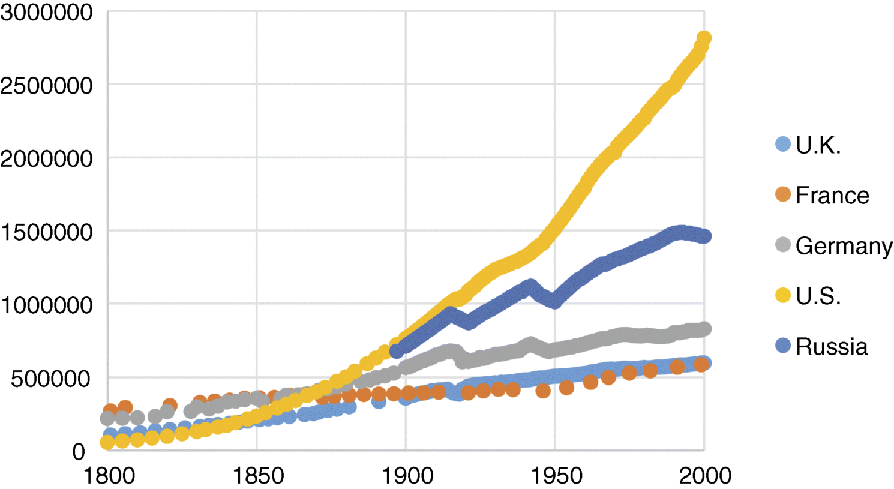
Figure 8.2 Historical population in the United States, Russia, Germany, the United Kingdom, and France (1801–2000)
Data Source: B. R. Mitchell, International Historical Statistics (3rd and 4th edn); Statesman's Yearbook (1930–2001); Demographic Yearbook/United Nations (195X–); “Suomen tilastolinen vuosikirja” 1998; A Hundred Year (1890–1990) Database for Integrated Environmental Assessments/C. G. M. Klein Goldewijk and J. J. Battjes, 1997.
Although the United States was already an innovative country in the early 1890s, it still lagged behind Continental Europe in basic science and research. It is unsurprising, therefore, that the number of U.S. Nobel Laureates was far lower than those from Germany. However, despite the lack of world-class scientists, U.S. innovation surpassed Europe thanks to its huge market, which provided the greatest opportunities and incentives for inventors and entrepreneurs to focus on commercial innovations. Electricity was first discovered in Europe, but U.S. entrepreneurs such as Thomas Edison and Nikola Tesla pioneered its commercial application. By 1925, New York became the world's largest city, with a population of more than 7 million, which was more than double the size of Paris and Berlin. Helped by the largest market, U.S. firms were able to achieve economies of scale earlier than European firms in the commercialization of new technologies such as electricity. Also, thanks to its large market, U.S. firms were the first to introduce the assembly line mass-production process. The first Ford Model T car was mass produced in 1908; as a result, the unit production cost plummeted and productivity soared, and U.S. automobile firms, capitalizing on their success, became the leading innovators of the world.
The advantage of scale not only helped in the innovation of consumer goods, but also capital goods. For example, with many potential manufacturing firms as customers, suppliers of machinery in the United States were able to develop specialized machinery and sell it in large volumes, ushering in many innovations in this sector during the early 1890s.
By the early 1890s, the United States already had more than twice the population of the next largest country in the Western world, and it became an economic superpower before the First World War. When the United States used its economic might in the context of a war effort, its scale advantage proved decisive. Its intervention and direct involvement won two world wars and changed world history. After the Second World War, the United States enjoyed an even greater advantage in terms of demographics. Many scientists, including Jewish scientists, joined U.S. universities, which helped the United States to surpass Europe in basic scientific research. Because the United States continued to attract significantly more immigrants than Europe, and had a higher fertility rate than Europe, by the 2000s, the U.S. population grew to 300 million, which is larger than the combined populations of the United Kingdom, Germany, France, and Italy, and three times larger than that of Japan. It was not until recently that China was able to match its market size. Not surprisingly, for most of the last century, the United States has had the best universities and the best companies, and it has dominated the world in terms of innovation.
Owing to its size advantage, the United States is far ahead of other countries in terms of information technology, financial services, the media industry, and military technology. The only exception is a number of European and Japanese companies that have retained a lead in several manufacturing industries. The reason that European and Japanese companies can still compete with the United States in manufacturing, with a much smaller home market, is because in manufacturing, product specification and quality performance is objective and observable, so it is much easier to export a manufacturing product than to export a service or a software product or film. For example, the Finnish company Nokia can achieve worldwide scale without a large home market. Nokia once had a very innovative and successful mobile phone product.
However, the share of the manufacturing industry in the modern economy is gradually eroding and giving way to service, software, and Internet industries. In these non-manufacturing industries, the product is not readily exportable, and perfecting a service product/technology involves joint creation between the firm and the customers. So, a large home market becomes a very important advantage. For this reason, U.S. companies disproportionately dominate the service and information technology industries. For example, the United States has the largest logistics companies, such as FedEx and UPS, the largest restaurant and hotel chains, as well as the largest financial services firms. The market share of U.S. firms in the global service industry is much larger than that of European or Japanese firms. Typically, these U.S. firms achieved scale and perfected their products in the U.S. market before they captured the markets of other countries and became successful global brands. Therefore, it is not surprising that U.S. software and Internet companies now dominate globally. When mobile phones became a service/software product rather than simply a manufactured product, United States-based Apple overtook Nokia.
Does the United States have an Inherent Advantage in Innovation?
The question now arises: Will the United States be able to successfully withstand the challenge from China? Vice President Joe Biden once said that the United States is hardwired for innovation while China is not. He also stated that the strength of the United States lies in three areas: the political system, the economic system, and the education system. I disagree—these three areas are not sources of U.S. strength in innovation.
First, the political system is not related to innovation, because many democratic countries are not successful innovators. Almost all European countries are democracies, but Southern and Eastern European countries have very low levels of entrepreneurship and innovation because of their small market size, aging population, and net negative immigration. During the 1970s and 1980s, Singapore, Taiwan, and South Korea were arguably not democratic, but they were quite successful innovators.
Second, the economic system is not a sustainable source of advantage either. The policy ingredients for innovation are trade liberalization, minimal regulation, good infrastructure, and good property protection (including intellectual property protection). Most countries understand these ingredients, and are capable of providing them. China has pursued a market-based economy, has an open economy with good infrastructure, and has started to enforce intellectual property protection laws. A good economic system is not unique to the United States.
Third, the education system is only partially an advantage for the United States. Although the United States has a very small number of elite private high schools, the overall U.S. high-school education can objectively be assessed as worse than that of most of the developed world, and significantly worse than East Asian countries on average. Some people say that due to their rote-learning school system, Chinese students are incapable of becoming innovators. This is a myth. Even though high-school students in China lead a miserable life with a heavy study load, there is no evidence that studying too hard hurts their creativity later in life. Japanese students have always endured the same kind of education as Chinese students, and yet they came up with the Walkman, video games, and many other great inventions during the 1970s and 1980s. Only recently has the capacity of the Japanese to invent suffered, as a result of its aging workforce. Korea has a similar education system to China, but Korea has been very successful in terms of innovation in the automobile industry, home appliances industry, and many other industries. Recently, many Chinese firms have become successful innovators in high-tech industries, and this has little to do with the system of education.
The United States still leads the world in higher education, especially in graduate and PhD programs, but this is because U.S. universities can attract the best students and scholars from around the world. If the United States has any hardwired advantage, it lies in its ability to attract more talent from the rest of the world, as well as, to a much lesser extent, a relatively high fertility rate for a developed country.
The Fertility Advantage
The much higher population growth in the United States is a result of a higher level of fertility and immigration. Let's first look at the fertility rate (Figure 8.3). The United States has the highest fertility among all the developed countries. Its fertility of 2.0 is near the replacement level, and is much higher than the European average of 1.5. Even if we just look at the Caucasian population, the fertility rate is higher than that of Europe (Figure 8.4).
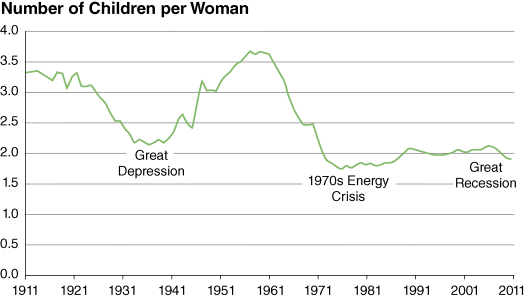
Figure 8.3 Overall fertility trend in the United States
Data Source: National Center for Health Statistics, 2012.
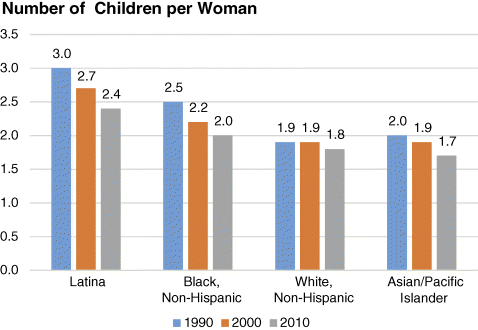
Figure 8.4 Fertility by ethnic group in the United States
Data Source: National Center for Health Statistics, 2012.
Why does the United States have an exceptionally high fertility rate in comparison with other developed countries? Scholars are still debating this question. It seems that there is more than one reason. The first reason is religion; the proportion of religious people in the United States is higher than that in Europe, and religious people tend to value both marriage and large families (Figure 8.5). For example, the Mormons and Catholic Hispanics have high fertility rates when compared with the general population.
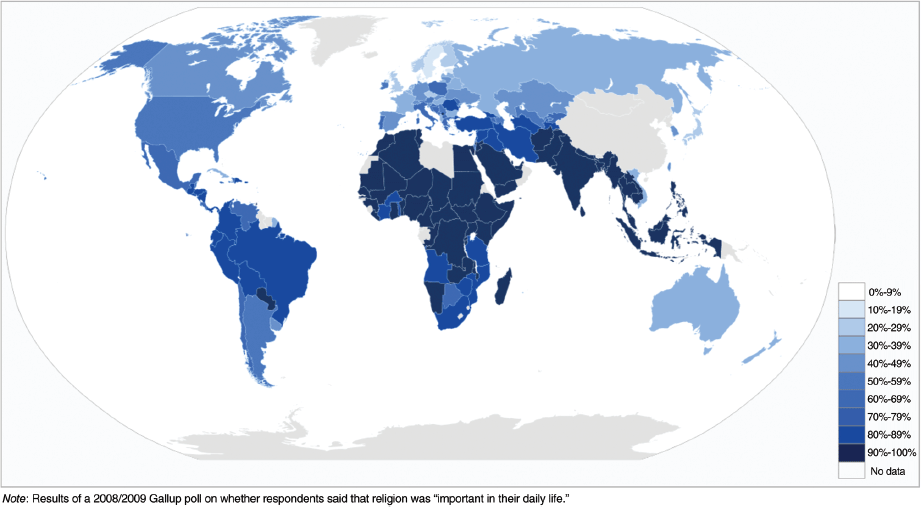
Figure 8.5 Religiosity map of the world.
Data Source: Crabtree Steve, Religiosity Highest in World's Poorest Nations, Gallup Global Reports, Retrieved May 27, 2015.
The other reason is the country's relatively inexpensive housing. In contrast to East Asian countries, such as China, Korea, and Japan, most Americans live in suburban areas where the cost, per square meter, of housing is much lower, and space is usually not a constraint to having more children.
But is this fertility advantage sustainable? I think the fertility advantage will diminish over time because, with the globalization of media and culture, the younger generation will adopt a lifestyle and attitude on family size that is more similar to that of Europe. Also, more and more young Americans are moving to large cities, where real-estate prices are becoming more expensive due to the agglomeration effect.
Immigration Advantage
The ultimate sustainable innovation advantage enjoyed by the United States in contrast to the rest of the world is immigration. The United States became a superpower mostly as a result of consistent pro-immigration policies, which led to a constant influx of immigrants into the country. It will now have to rely on immigration again to sustain its leadership position on innovation. The United States currently attracts about 0.5 to 1 million immigrants a year (Figure 8.6). The skill level of the immigrants is polarized. On the one hand, most of the immigrants only have a high-school diploma or even less formal education; on the other hand, the share of master's degree/PhD holders is a lot higher than that of the native-born population. I define unskilled workers as those without a college degree, and highly skilled workers as those with a college degree or higher. Approximately more than half of these immigrants are unskilled immigrants, mostly from Latin America, but there are also a few hundred thousand highly skilled workers arriving yearly, mostly from Europe and Asia.
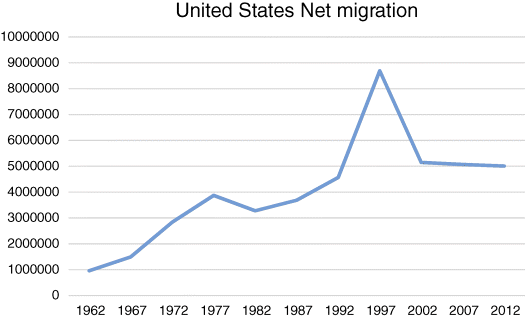
Figure 8.6 U.S. net migration
Data Source: World Development Indicators, 2012.
Many researchers have demonstrated that immigrants tend to be more innovative and entrepreneurial, and they have more children than natives, even when their education is taken into consideration. A highly skilled immigrant to the United States is on average twice as likely to hold a patent and 30% more likely to start a successful company (Hunt, 2010).
U.S. universities attract many talented students every year. The share of foreign-born PhD graduates ranges from 10% to almost 50%, depending on the major (Figure 8.7). In computer science and engineering majors, the percentages are 45% and 47%, respectively. Most of these PhD graduates stay and work in the United States for their entire career. They represent the best and brightest of their home country, and many of them later become leading researchers and entrepreneurs. About half of the successful high-tech companies in the United States have one or more immigrant founders. If we include the children of first-generation immigrants, more than half of the engineers in Silicon Valley are from immigrant families. In many high-tech firms, the share of inventions by ethnic Indian and Chinese has reached 20–40%, and is still growing (Kerr and Lincoln, 2010). Most of the ethnic Indian and Chinese are first- and second-generation immigrants.

Figure 8.7 Share of foreign-born PhD candidates in U.S. universities (%)
The United States is uniquely successful at attracting immigrants, because it already has more immigrants than any other country in the world, which is an example of a classical network effect (Figure 8.8). This makes it easier for newcomers to leverage ethnic groups to find friends and jobs. Moreover, a growing population and a dynamic economy provide more jobs and innovation opportunities, which attract even more immigrants. Lastly, more immigrants will make the country more diverse and tolerant, culturally and politically (and thus more attractive to immigrants). This scale and network effect of immigration is an advantage that no other country has the ability to mimic any time soon. In contrast, China (as well as other large economies) has a relatively homogeneous population, and it is difficult to see China becoming a country that attracts a significant number of immigrants.

Figure 8.8 International students in the United States, the United Kingdom, Canada, and Australia
Data Source: Project Atlas Australia, International students in Australia, 2013.
English is also an advantage for the United States because it makes it easier for newcomers to assimilate. English-speaking countries are the most popular destinations for immigrants and international students. Figure 8.8 compares the number of foreign students in four countries. Among all the English-speaking countries, it is clear that the United States is the most attractive to international students. Also, because it has the largest population and economy, the United States is able to offer many students the chance to stay and work on completion of their studies. This is one of the reasons why many international students in the United Kingdom, Canada, and Australia end up working or attending graduate school in the United States after they finish their undergraduate studies.
Immigration is a unique advantage of the United States, but can this be a lasting advantage? I believe that it can, unless, of course, the United States self-imposes restrictions on immigration, like it did many times throughout its history. In U.S. history, periods of open immigration coincided with periods of prosperity and periods of low immigration preceded periods of decline. It is not a coincidence that before the Great Depression, in 1924, the United States introduced immigration laws to greatly reduce the number of immigrants. In periods of economic difficulty, politicians often scapegoat immigrants for problems such as unemployment and inequality.
Is Inequality a Problem?
In recent years, income inequality in the United States has worsened; the share of pre-tax income received by the richest 1% of Americans rose from 13.3% in 2009 to 14.6% in 2011. During 2012 alone, the incomes of the wealthiest 1% of Americans rose nearly 20%, whereas the incomes of the remaining 99% rose only 1% (Figure 8.9).
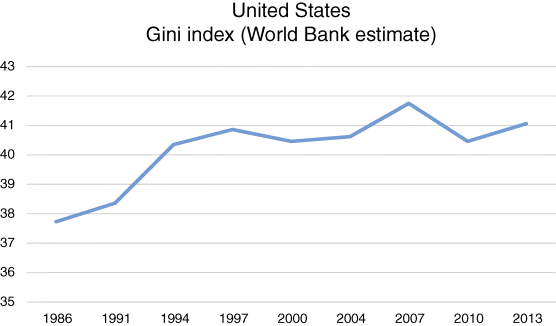
Figure 8.9 The U.S. Gini index
Data Source: World Bank, United States Gini index, 2015.
The United States ranks on the 30th percentile in income inequality globally, meaning that 70% of countries have a more equal income distribution.
Meanwhile, the United States has the strongest economy and the most dynamic IT industry among all developed countries. The rise in inequality and the rise of the IT industry are not just a coincidence. Information technology makes some workers more productive, and they are the IT engineers and other highly skilled workers with skills complementary to technology. Highly skilled engineers and entrepreneurs in the IT and related industries make a lot more money than they previously could, resulting in a widening income gap in the United States.
Income redistribution is not a good solution, because it will dampen the incentive for innovation and entrepreneurship. A better way to level the playing field is to raise the skill level of the poor, but this is also difficult to do. Throwing resources at the poor is unlikely to significantly raise their level of education, because there are complicating factors such as culture.
As explained in Chapter 5, highly skilled immigration can help solve the inequality problem. Increasing the number of highly skilled immigrants will increase the supply of highly skilled workers, hence reducing the wage premium paid for their skills. At the same time, more highly skilled workers will increase demand for unskilled jobs, as highly skilled workers will demand more gardeners, plumbers, maids, and so on. This increased demand will also increase the wages for unskilled workers and further drive down inequality.
China vs. the United States
In about 10 years' time, China will be a wealthy nation with an economy larger than that of the United States and a population four times its size. China will certainly have a home market larger than that of the United States, but because of the immigration advantage and the language (English) advantage, the United States may still have a chance to come out on top.
For some markets, such as the gaming and entertainment industries, the market boundary is not national borders but rather language or cultural boundaries. For example, a Chinese film has a market size of 1.3 billion, but an English film has a market size of close to 2 billion (with most people in Europe and India also being potential customers). Most service products, such as Internet or software products, are like the movie industry, where the boundaries are culture and language, rather than national borders.
In terms of talent pool size, China will have a much larger pool of college students and researchers than the United States. However, in terms of the quality of students or researchers, the United States will continue to enjoy an advantage over China, since graduate schools at U.S. universities will still be a magnet for the best undergraduate college students around the world. This means that the United States will effectively have a global talent pool that it can draw upon that is several times larger than that of China.
Also, the U.S. population will be much younger than that of China, because of the much higher fertility and immigration rate. For example, by 2040, the median age of the Chinese will be over 45, but only 40 in the United States (Figure 8.10). As I explained in Chapter 2, an aging country is likely to be much less innovative and entrepreneurial.

Figure 8.10 The prediction of population structure in 2040
Data Source: U.S. Census Bureau, 2015.
Policy Recommendations
The United States should try to attract more international students to study and work in the United States upon graduation.
- Offer more working visas to international students upon graduation from U.S. universities.
It is estimated that there are more than 1 million international students in the United States. Most of them pay full tuition fees, and desire to stay in the United States after graduation. The United States should allow these students to work and pay tax upon graduation with no conditions attached; it is the sending country that should believe itself at a disadvantage and be concerned about a brain drain.
- Expand both undergraduate and graduate programs.
The demand for U.S. education is high; it is estimated that the number of students from China alone will triple over the next 10 years. Similarly, as Indian parents become wealthier they will also send more of their children to study in the United States. Soon, there will be huge capacity shortages in U.S. colleges, primarily due to increasing demand from India and China alone. Let's do a back-of-the-envelope forecast of demand from China. It could well be that 10% of the college student cohort in China would want to study outside of China for undergraduate or graduate study (i.e. 10% of 8 million college students each year). Of the 800,000 million Chinese international students a year, I estimate that 50% will want to study in the United States (which is by far the most popular choice of destination). Therefore, 400,000 Chinese students will apply for U.S. colleges every year. Other countries, such as India, Korea, and Vietnam, will also see huge increases in the number of students who want to study in the United States. Currently, U.S. colleges grant about 2 million bachelor's degrees a year. Unless the United States is prepared to grant 20% of its college degrees to students from China alone, there will be a huge shortage of supply for college education in the United States.
If higher education were a private industry, the colleges would be very happy to continue to grow their business, but unfortunately, most educational institutions are not-for-profit entities. Universities brag about low admission rates and exclusivity, and unlike companies who seek to maximize profit, they are very reluctant to expand. I am not sure what the solution will be, but high demand for U.S. education will be a happy problem for the United States to solve (if the best American universities can somehow meet the growing demand by either expanding their facilities or allowing more online instruction). Such expansion would be a great boost for the education sector and the economy in the long run.
- Allow more highly skilled immigrants into the United States.
If we define highly skilled immigrants as those with at least a college degree, the United States can admit about 400,000 highly skilled immigrants each year. However, the H1 B (employment visa) is capped at only a little over 100,000 a year. The United States should take all the highly skilled immigrants that it can get.
Many economists think that the United States should allow all international students with a college degree to work and live in the country. The United States currently grants about 2 million bachelor's degrees a year. If 20% of degrees are awarded to international students and 80% of them want to stay and work, this amounts to 320,000 college graduates (20% × 2 million × 80%). Therefore, a 100,000 employment visa quota is less than one-third of the potential highly skilled immigrants who are likely to be available simply by way of the higher education system. When I worked at Oracle in the 1990s, because of the long queue for H1 visas, Oracle and many high-tech firms in Silicon Valley were forced to open large research and development centers outside the United States. This was detrimental to the U.S. economy, both in the short and long term!
The United States should dramatically raise the availability of employment visas to around 600,000 per year, including 300,000 for recent graduates and 300,000 for experienced, highly skilled workers. Assuming that each highly skilled worker will bring one relative on average, this would double the size of the current annual immigration from 1 million to 2 million. Two million a year in absolute terms will be the largest immigration figure in the history of the United States, but as a ratio of the total population, it is only 0.7% a year (a much lower ratio of immigration compared with that 100 years ago). At 0.7% a year, the United States easily has the capacity to absorb and provide basic public services for these newcomers. A total of 600,000 highly skilled workers a year would be a great boost for U.S. competitiveness, with the added bonus of helping to reduce inequality.
- Expand infrastructure and public services.
In order to gain broad public support to admit many more immigrants a year, the United States needs to build more infrastructure such as roads, hospitals, and schools. This is certainly achievable given the relatively modest size of the immigrant pool vis-à-vis the total population. Moreover, infrastructure investment will boost the economy and generate more employment, particularly for the unskilled labor pool (once again contributing to the reduction in inequality).
Predicting the Effects of Donald Trump's Presidency
Donald Trump ran on the platform of anti-globalization, a platform that supposedly would help unskilled workers, but one that is clearly bad for both businesses and the economy. On the other hand, Donald Trump also has a traditional conservative agenda of lower taxes and a smaller government, something that is good for both businesses and the economy. These are seemingly conflicting agendas, trying to achieve what seem to be polar opposite goals.
I would argue that an anti-globalization agenda, even if implemented successfully, is not going to help the affected workers much, because the manufacturing jobs that Donald Trump wants to return to the United States are unskilled jobs that will soon likely be replaced by robots in any case. It is quite ironic that Trump wants iPhones made in the United States but at the same time Foxconn, the company that employs millions of workers (mostly in China) to produce iPhones for Apple, is pushing hard to replace Chinese workers with robots. Do we really want American workers to compete with robots in China?
The answer is no. Instead, Donald Trump should be fighting to have more robots that are made in the United States. This requires the United States to have the best scientists and engineers in the world. The key to increasing the number of American jobs is to attract the best talent—including engineers, professors, and students—to stay and work in the United States. It seems contradictory that to create more jobs we need more immigrants but, as explained in this book, immigrants (especially highly skilled immigrants) create additional highly skilled jobs due to the agglomeration effect, which will further strengthen the United States as the pre-eminent center of global innovation. Moreover, highly skilled immigrants also create demand for unskilled jobs (such as gardeners, waiters, and barbers), and help close any emerging inequality gap. If one understands the economics of innovation and immigration, allowing more high-skill immigration is an easy policy choice. It remains to be seen, of course, whether Donald Trump's presidency will be a sensible one.
The Thucydides Trap: A Conflict between China and the United States
The Thucydides trap, named after the Ancient Greek historian, refers to the prediction that an incumbent superpower (such as the United States) will almost always wage war with an emerging superpower (such as China). The newly elected U.S. president has promised to “get tough” with China. The territorial dispute in the South China Sea seems to be escalating to a standoff between China and the South East Asian nations, which are often backed by the U.S. military.
Obviously, a military conflict between the United States and China would be disastrous for both countries and the world. Unfortunately, historically the new and old have all too often ended up in conflict, whether this was Germany and Britain, Athens and Sparta, or America and Japan.
However, I would argue that this time will be different. During the agricultural and industrial ages, countries went to war to compete for land, labor, and natural resources. Today, innovation and technology are the most important factors in an economy, and they reside in people's brains. In other words, the innovator's mind is the key resource. Even in the event of a war, a country can be victorious over another country and possess all of its natural resources, and yet it cannot suborn its human resources or the minds of its people. For example, in the unlikely event of a foreign army successfully occupying Silicon Valley, innovation there would stop almost immediately. Engineers at Google would simply leave the war-torn country and start a new search engine elsewhere. One cannot force people to be creative. When human resources and innovative minds become the most valuable asset, the motives for traditional war disappear.
Today, economic competition is not a war for resources, but rather a war for talent. A war for talent is not a war but a beauty contest, where countries compete to provide the most beautiful and safest cities, with the best public services and infrastructure, to attract the most talented minds. Today, the best minds are also very mobile. Any aggressive military standoff will create fear and insecurity, causing the most talented people to emigrate to countries they deem to be safer. Aggressors are unlikely to be able to capitalize on their belligerence.
Even though China will soon be the largest economy globally, its military power is still years behind that of the United States. In addition, by 2040, the Chinese economy will have an aging population; typically, an aging country becomes very conservative in terms of domestic and foreign policy. China's innovation capacity will also suffer as a result of an aging society. The United States, on the other hand, with its growing population and a constant inflow of talent from around the world, will likely regain the leadership in technology and innovation in the latter part of the century.
